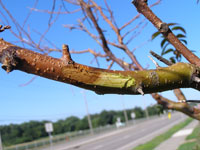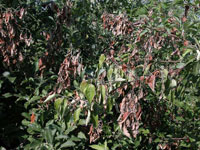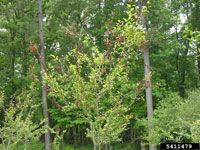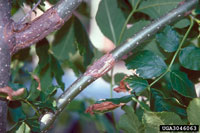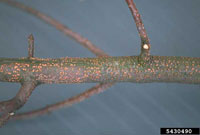Extension > Garden > Diagnose a problem > What's wrong with my plant? > Deciduous > Cotoneaster > Bark on branches sunken, cracked or blistered
Cotoneaster > Stems/branches > Bark on branches sunken, cracked or blistered
1 of 3
Fire blight
Erwinia amylovora
- Infected flowers appear water-soaked, shrivel and turn brown or black
- Leaves wilt, turn reddish brown; appear as though scorched by fire and cling to twigs
- Infected shoots turn brown and bend into a shepherds' crook
- Cankers on older branches cause bark to be dark, cracked and sunken
- More information on fire blight
2 of 3
Botryosphaeria canker
Botryosphaeria dothidea
- Leaves on one or more branches wilt, die and turn brown
- Bark on affected branches is darker, cracked, or blistered at the site of the canker
- Wood beneath the canker is dark brown
- Common on shrubs stressed by drought, winter injury and other factors
- More information on Botryosphaeria canker
3 of 3
Nectria canker
Nectria cinnabarina
- Dead branches and twigs, often first observed in early spring
- Bark at the base of dead branches is slightly sunken, discolored or cracked
- Tiny, pink, pale orange or cream colored cushion-like spore-producing bodies are visible in cracks in bark in spring
- In summer, smaller coral colored bumps push through cracks
- In autumn these spore-producing structures are dark brown or black
- More information on Nectria canker



